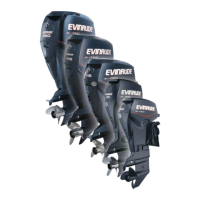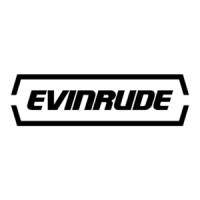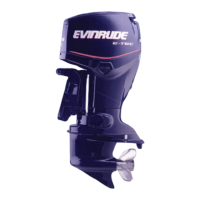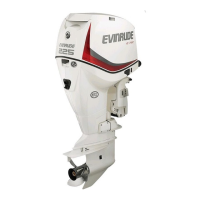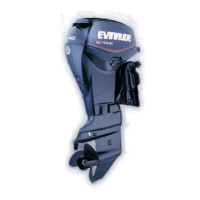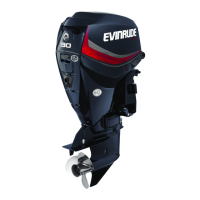Do you have a question about the Evinrude E-TEC E40DPLSCB and is the answer not in the manual?
Provides detailed engine specifications including RPM ranges, power, bore, stroke, and lubrication requirements.
Covers the essential steps for rigging the outboard motor, including controls and battery installation.
Details the procedures for mounting the outboard motor onto the boat transom, including hull preparation.
Covers the procedures for mounting the outboard motor, including height and bolt installation.
Covers critical checks to perform when the outboard is running, including engine monitoring and fuel system checks.
Outlines routine inspection and maintenance intervals and tasks for prolonging outboard life.
Details the critical service procedures for outboards submerged in water to prevent corrosion.
Provides an overview of the EMM's function as the water-cooled engine controller.
Warns the operator of conditions that could damage the outboard and sends data to networks.
Alerts the operator and protects the engine from damage by adjusting speed or shutting down.
Explains how to perform dynamic tests to diagnose cylinder performance and fuel control.
Describes the meaning of EMM LED indicators for diagnosing system status and faults.
Provides a diagram and description of the electric start circuit components and connections.
Covers testing of the SystemCheck gauge circuits, including self-test and individual warning lights.
Covers tests for fuel system components like the pressure regulator and injectors.
Covers tests for the oil injection pump, including static, voltage, and function tests.
Outlines methods for checking engine temperature using software or a pyrometer.
Provides procedures for the disassembly, inspection, and assembly of the thermostat.
Details the servicing procedures for the pressure relief valve assembly.
Details the initial steps for removing the powerhead, including disconnecting various hoses and connectors.
Outlines the general steps for disassembling the powerhead, including component removal.
Provides instructions for cleaning carbon deposits, cylinder walls, and port edges.
Covers visual inspection of powerhead components for wear, damage, or heat discoloration.
Outlines procedures for assembling internal powerhead components, emphasizing cleanliness.
Covers the installation of the crankshaft and connecting rods, including torque sequences.
Provides detailed engine specifications including RPM ranges, power, bore, stroke, and lubrication requirements.
Covers the essential steps for rigging the outboard motor, including controls and battery installation.
Details the procedures for mounting the outboard motor onto the boat transom, including hull preparation.
Covers the procedures for mounting the outboard motor, including height and bolt installation.
Covers critical checks to perform when the outboard is running, including engine monitoring and fuel system checks.
Outlines routine inspection and maintenance intervals and tasks for prolonging outboard life.
Details the critical service procedures for outboards submerged in water to prevent corrosion.
Provides an overview of the EMM's function as the water-cooled engine controller.
Warns the operator of conditions that could damage the outboard and sends data to networks.
Alerts the operator and protects the engine from damage by adjusting speed or shutting down.
Explains how to perform dynamic tests to diagnose cylinder performance and fuel control.
Describes the meaning of EMM LED indicators for diagnosing system status and faults.
Provides a diagram and description of the electric start circuit components and connections.
Covers testing of the SystemCheck gauge circuits, including self-test and individual warning lights.
Covers tests for fuel system components like the pressure regulator and injectors.
Covers tests for the oil injection pump, including static, voltage, and function tests.
Outlines methods for checking engine temperature using software or a pyrometer.
Provides procedures for the disassembly, inspection, and assembly of the thermostat.
Details the servicing procedures for the pressure relief valve assembly.
Details the initial steps for removing the powerhead, including disconnecting various hoses and connectors.
Outlines the general steps for disassembling the powerhead, including component removal.
Provides instructions for cleaning carbon deposits, cylinder walls, and port edges.
Covers visual inspection of powerhead components for wear, damage, or heat discoloration.
Outlines procedures for assembling internal powerhead components, emphasizing cleanliness.
Covers the installation of the crankshaft and connecting rods, including torque sequences.
| Horsepower | 40 hp |
|---|---|
| Cylinders | 2 |
| Starting System | Electric |
| Cooling System | Water Cooled |
| Full Throttle RPM Range | 5000-6000 RPM |
| Gear Ratio | 2.00:1 |
| Steering | Remote |
| Oil Injection | Yes |
| Warranty | 3 years |
| Engine Type | 2-stroke |
| Fuel System | Direct Fuel Injection (DFI) |
| Shaft Length | 20 in |
